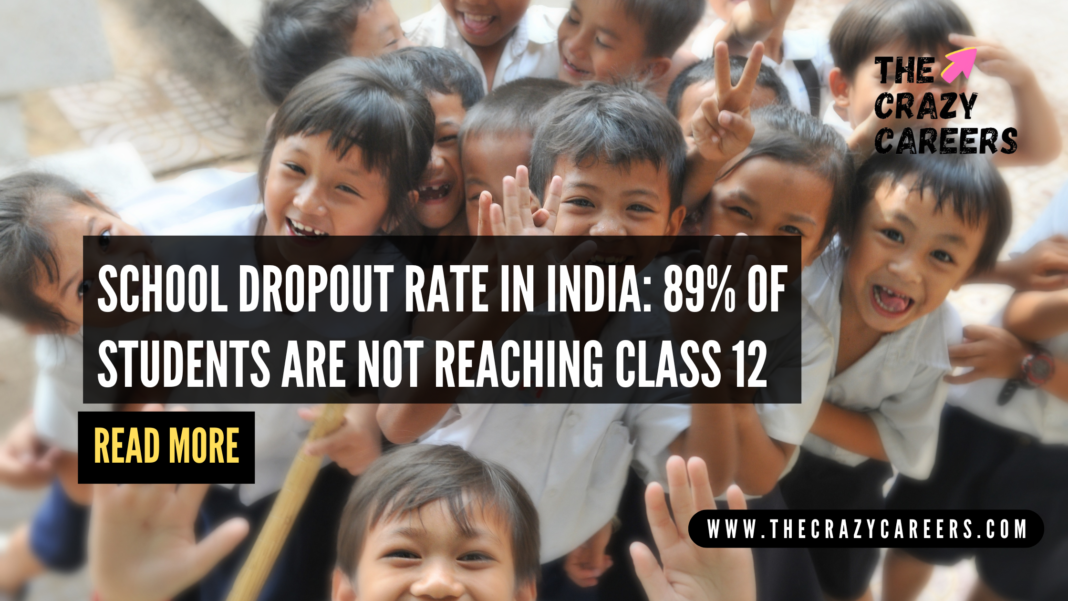India’s education system is grappling with a high dropout rate, with 89% of students failing to reach Class 12. According to the Unified District Information System for Education Plus (UDISE+), 2023-24, a total of 24.8 crore students were enrolled across different education levels. However, the percentage distribution of students highlights significant gaps. As per the report, only 11% of students reach the secondary level, and just 5% continue to higher secondary education, indicating a steep decline in enrolment beyond primary education.
The data also reveals that 44% of students are enrolled at the primary level, while 25% continue to upper primary. This drop in retention underscores deep-rooted challenges such as economic struggles, gender disparity, poor infrastructure, and social pressures. What are some reasons for School Dropout Rate in India?
Watch our Podcast | The Crazy Careers Podcast
Reasons Behind the High School Dropout Rate in India
Financial Struggles and Economic Pressure
Many students, especially in rural areas, quit school due to financial burdens. Families often prioritize work over education. “India’s staggering 89% school dropout rate stems from economic difficulties. Many students, particularly in rural areas, drop out to support their families. A shift towards vocational education and scholarships is imperative to increase retention and ensure equitable education.” — Mr. Akash Sharma, Director Admission & Outreach, Noida International University
Poor Infrastructure and Limited Access to Schools
Lack of proper infrastructure is another key reason for high dropout rates. Many students travel long distances to attend school. Schools with poor facilities discourage students from continuing education. “Financial pressure, poor access to schools, and lack of infrastructure contribute significantly to dropouts. In many regions, schools are either too far or ill-equipped, leaving students with no choice but to quit. Addressing these issues through better policies and vocational pathways is crucial.” — Ms. Ritika Gupta, CEO, Aaera Consultants
Early Marriages and Social Barriers
Many families still believe marriage is more important than education, especially for girls. This outdated mindset forces young students to drop out. “Families often prioritize marriage over education, especially for girls. The absence of career counseling and gender imbalance in education further exacerbates the dropout rate. Radical changes in education access and policies are necessary to prevent students from leaving school prematurely.” — Ms. Mamta Jani, Founder, On Track Education
Solutions to Reduce the School Dropout Rate in India
Strengthening Vocational Education
Vocational training can provide students with practical skills, making education more relevant. Schools should integrate skill-based courses to encourage students to complete their studies.
Increasing Financial Aid and Scholarships
Providing financial aid can prevent students from quitting school. More government and private-sector scholarships are needed to support underprivileged students.
Enhancing Digital and Community-Based Learning
E-learning platforms can help students who lack access to schools. Community-driven initiatives can also provide local education support and reduce dropout rates.
Also Read | Student Dropout Percentage in India is Higher for Boys
The high school dropout rate in India is a major challenge that needs immediate attention. By improving infrastructure, offering financial support, and promoting vocational training, India can create a more inclusive education system. A well-educated population will drive economic growth and social development, securing a brighter future for the nation.
Source: Government of India, Ministry of Education, Department of School Education & Literacy. Report on Unified District Information System for Education Plus (UDISE+), 2023-24.




